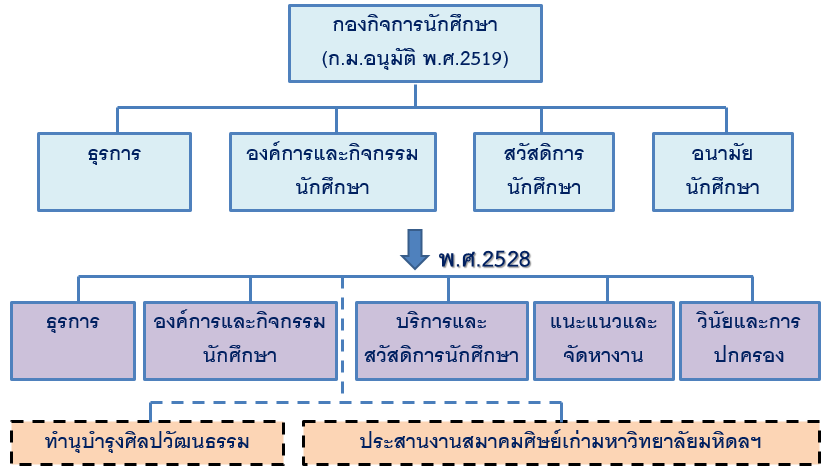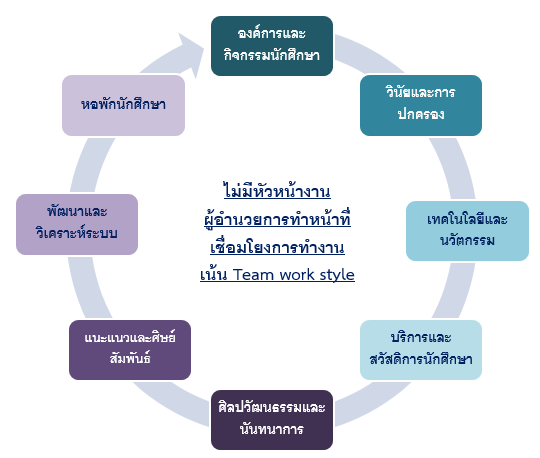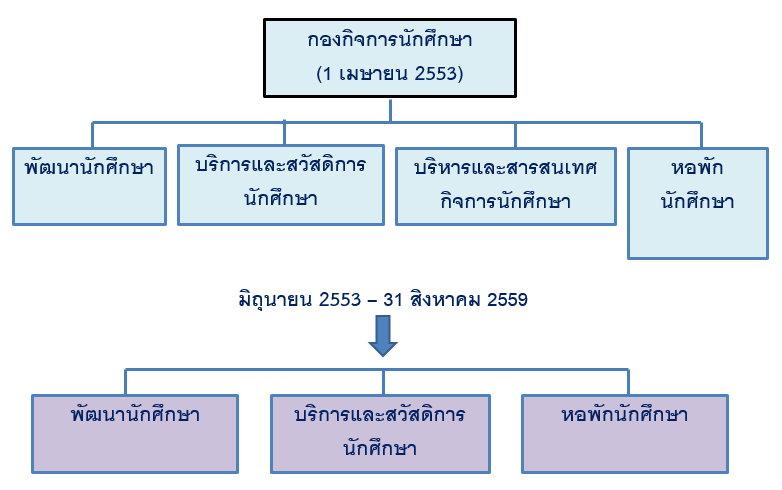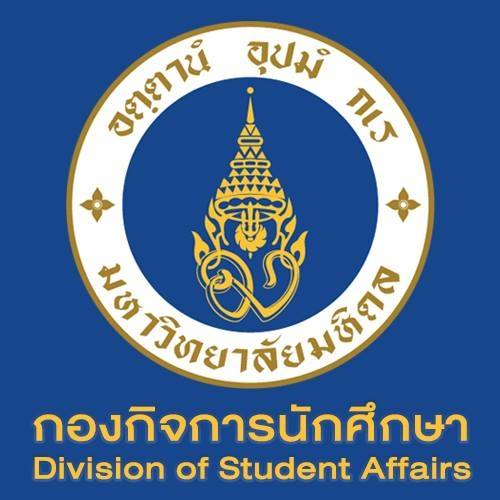กองกิจการนักศึกษา มหิดล
ประวัติหน่วยงาน
กองกิจการนักศึกษา มหาวิทยาลัยมหิดล มีประวัติศาสตร์ เริ่มตั้งแต่การได้รับอนุมัติจาก ก.ม.เมื่อวันที่ 31 สิงหาคม 2519 ให้มีกองกิจการนักศึกษาเป็นครั้งแรก โดยอยู่ในสังกัดสำนักงานอธิการบดี และมีการแบ่งส่วนราชการของกองกิจการนักศึกษาออกเป็น 4 หน่วยงาน คือ งานธุรการ งานองค์การและกิจกรรมนักศึกษา งานสวัสดิการนักศึกษา งานอนามัยนักศึกษา และยังคงให้รับผิดชอบงานด้านโครงการส่งเสริมการศึกษาแพทย์สำหรับชาวชนบท ซึ่งเริ่มดำเนินการมาตั้งแต่ปี พ.ศ.2518 ต่อมาเมื่อวันที่ 13 สิงหาคม 2528 ก.ม.ได้อนุมัติการแบ่งส่วนราชการของกองกิจการนักศึกษาใหม่ โดยเพิ่มงานใหม่เข้ามาอีกสองงาน คือ งานแนะแนวและจัดหางาน กับงานวินัยและการปกครอง แต่ได้รวมเอางานสวัสดิการและงานอนามัยนักศึกษาไว้ด้วยกัน เรียกว่า งานบริการและสวัสดิการนักศึกษา ฉะนั้น ในปี พ.ศ.2528 ส่วนราชการของกองกิจการนักศึกษาจึงมีทั้งสิ้น 5 งาน
นอกจากนี้ยังได้รับมอบหมายงานที่นอกเหนือจากงานในโครงสร้างประจำ เพิ่มอีก 2 งานได้แก่ งานทำนุบำรุงศิลปวัฒนธรรม และงานประสานงานสมาคมศิษย์เก่ามหาวิทยาลัยมหิดล ในพระบรมราชูปถัมภ์
ภาพที่ 1 ประวัติศาสตร์โครงสร้างการบริหารงานกองกิจการนักศึกษา มหาวิทยาลัยมหิดล ตั้งแต่ พ.ศ.2519-2528

ต่อมาเมื่อเดือนธันวาคม พ.ศ.2550 มหาวิทยาลัยมหิดลได้แต่งตั้งทีมบริหารชุดใหม่ หลังจากชุดเดิมหมดวาระลง ภายใต้การนำของ ศาสตราจารย์เกียรติคุณ นายแพทย์ปิยะสกล สกลสัตยาทร อธิการบดี จึงได้มีการปรับปรุงโครงสร้างของมหาวิทยาลัย โดยการยุบรวมศูนย์ศาลายาเข้ามาสังกัดสำนักงานอธิการบดี พร้อมทั้งเปลี่ยนชื่อเป็นกองกายภาพและสิ่งแวดล้อม และให้งานหอพักนักศึกษาซึ่งเดิมสังกัดศูนย์ศาลายา มาอยู่ในความรับผิดชอบของกองกิจการนักศึกษา ต่อมาเมื่อวันที่ 1 พฤษภาคม 2551 ผู้บริหารกองกิจการนักศึกษาได้มีการปรับโครงสร้างการบริหารงานแบบใหม่อย่างไม่เป็นทางการภายในหน่วยงาน มีลักษณะการบริหารงานแบบแนวราบ (Flat Organization) จำนวนทั้งสิ้น 8 งาน ได้แก่ งานองค์การและกิจกรรมนักศึกษา งานวินัยและพัฒนานักศึกษา งานหอพักนักศึกษา งานเทคโนโลยีและนวัตกรรม งานบริการและสวัสดิการนักศึกษา งานศิลปวัฒนธรรมและนันทนาการ งานแนะแนวและศิษย์สัมพันธ์ และงานพัฒนาและวิเคราะห์ระบบ
วัตถุประสงค์ของการปรับโครงสร้างแบบใหม่ครั้งนี้ เพื่อให้มีการประสานงานแบบเครือข่าย เน้นการทำงานเป็นทีม (Team work style) สามารถเรียนรู้งานข้ามสายงานกันได้ ไม่มีหัวหน้างานบุคลากรมีการปฏิบัติงานแบบสำนักรับผิดชอบ มีเป้าหมายร่วมกัน และผู้บังคับบัญชามีหน้าที่ให้คำแนะนำและแนะแนวทางปฏิบัติ
กองกิจการนักศึกษา มหิดล
ภาพที่ 2 ประวัติศาสตร์โครงสร้างการบริหารงานกองกิจการนักศึกษา มหาวิทยาลัยมหิดล (ตั้งแต่วันที่ 1 พฤษภาคม 2551)

ต่อมามหาวิทยาลัยได้ว่าจ้างบริษัทเอกชนเข้ามาวางระบบโครงสร้างการบริหารงานของมหาวิทยาลัยใหม่ โดยจัดกลุ่มการทำงานที่มีลักษณะเดียวกันอยู่ด้วยกัน ผู้บริหารกองกิจการนักศึกษาจึงได้ให้บุคลากรทุกคนร่วมกันคิดรูปแบบโครงสร้างและได้ข้อสรุปการแบ่งเป็น 4 งาน ดังนั้น กองกิจการนักศึกษาจึงได้เปลี่ยนโครงสร้างการบริหารงานจากแบบแนวราบ มาเป็นแนวดิ่งอีกครั้ง โดยเริ่มตั้งแต่วันที่ 1 เมษายน 2553 เป็นต้นไป แต่ยังคงรูปแบบการบริหารงานเหมือนเดิม คือ ไม่มีหัวหน้างานบุคลากรมีการปฏิบัติงานแบบสำนักรับผิดชอบ มีเป้าหมายร่วมกัน และผู้บังคับบัญชามีหน้าที่ให้คำแนะนำและแนะแนวทางปฏิบัติ ประกอบด้วย งานพัฒนานักศึกษา งานบริการและสวัสดิการนักศึกษา งานบริหารและสารสนเทศกิจการนักศึกษา งานหอพักนักศึกษา
และเมื่อบริษัทเอกชนได้วิเคราะห์และปรับปรุงโครงสร้างมหาวิทยาลัยแล้วเสร็จ กองกิจการนักศึกษาได้ถูกแบ่งตามภารกิจออกเป็น 3 งาน ได้แก่ 1) งานพัฒนานักศึกษา 2) งานบริการและสวัสดิการนักศึกษา และ 3)งานหอพักนักศึกษา โดยเริ่มตั้งแต่เดือนมิถุนายน 2553 ตามประกาศมหาวิทยาลัยมหิดล
ภาพที่ 3 ประวัติศาสตร์โครงสร้างการบริหารงานกองกิจการนักศึกษา มหาวิทยาลัยมหิดล (เริ่มตั้งแต่วันที่ 1 เมษายน 2553 ถึง 31 สิงหาคม 2559)

ปัจจุบันกองกิจการนักศึกษาได้มีการปรับโครงสร้างการบริหารงานภายใน เพื่อให้มีความสอดคล้องกับยุทธศาสตร์มหาวิทยาลัยมหิดล ปี พ.ศ. 2559-2562 และมีความชัดเจนด้านการบริหารงาน โดยการแบ่งหน่วยงานเพิ่มอีก 3 หน่วย ได้แก่ หน่วยศิษย์สัมพันธ์ หน่วยสื่อสารองค์กร และหน่วยบริหารงานทั่วไป ตั้งแต่วันที่ 1 กันยายน 2559 เป็นต้นมา ดังนั้น โครงสร้างการบริหารงานกองกิจการนักศึกษา จึงประกอบด้วย 3 งาน และ 3 หน่วย ซึ่งมีภาระหน้าที่ดังนี้
- งานพัฒนานักศึกษา รับผิดชอบงานด้านการกำกับดูแลการบริหารงานขององค์กรนักศึกษา ได้แก่ สภานักศึกษามหาวิทยาลัยมหิดล สโมสรนักศึกษามหาวิทยาลัยมหิดล ชมรมระดับมหาวิทยาลัย ส่งเสริมกิจกรรมองค์กรนักศึกษา ส่งเสริมสนับสนุนและจัดกิจกรรมพัฒนานักศึกษาด้านต่างๆ และขับเคลื่อนงานอาสาสมัครมหาวิทยาลัยมหิดล รวมถึงการดำเนินงานด้านวินัยนักศึกษาและวิชาทหาร
- งานบริการและสวัสดิการนักศึกษา รับผิดชอบงานด้านการพัฒนาคุณภาพชีวิตนักศึกษา ได้แก่ การให้คำปรึกษาด้านต่างๆ สร้างเครือข่ายนักศึกษาและบุคลากรด้านการให้คำปรึกษา การจัดหางานและฐานข้อมูลเพื่อการมีงานทำของนักศึกษา ทุนการศึกษา และกองทุนเงินให้กู้ยืมเพื่อการศึกษา ด้านการบริการและส่งเสริมสุขภาพนักศึกษา ได้แก่ การจัดสวัสดิการรักษาพยาบาลและทันตกรรมแก่นักศึกษา เงินสงเคราะห์นักศึกษาเสียชีวิตหรือทุพพลภาพขณะศึกษา จัดกิจกรรมด้านการสร้างเสริมสุขภาพนักศึกษา และด้านการบริการสนับสนุนสำหรับนักศึกษาพิการ (DSS)
- งานหอพักนักศึกษา รับผิดชอบงานด้านบริการที่พักอาศัยให้แก่นักศึกษา พร้อมจัดสวัสดิการและสิ่งอำนวยความสะดวกต่างๆให้แก่นักศึกษาภายในหอพักและบริเวณหอพัก รวมถึงการส่งเสริมสนับสนุนการจัดกิจกรรมพัฒนานักศึกษาในหอพัก พร้อมทั้งกำกับดูแลงานด้านอาคารสถานที่และสิ่งแวดล้อมหอพักนักศึกษาให้สะดวก สอาด พร้อมใช้งาน และมีระบบรักษาความปลอดภัยให้กับผู้พักอาศัยในหอพักนักศึก
- หน่วยศิษย์สัมพันธ์ รับผิดชอบงานด้านฐานข้อมูลศิษย์เก่าและเว็บไซต์ศิษย์สัมพันธ์ และสร้างเสริมความผูกพันธ์ศิษย์สัมพันธ์โดยการประสานงานกับเครือข่ายสมาคมและเสริมสร้างความผูกพันกับศิษย์เก่าอย่างต่อเนื่อง โดย Mahidol Alumni Engagement and Employability Focus โดยการให้เกียรติ เผยแพร่ข่าวสารและเชิญศิษย์เก่าเข้ามามีส่วนร่วมตามวิสัยทัศน์ของมหาวิทยาลัย รวมถึงรายงานจำนวนศิษย์เก่าที่ช่วยพัฒนามหาวิทยาลัยตามคำจำกัดความของความผูกพันเพื่อรายงานตามตัวชี้วัดตามยุทธศาสตร์ที่ 2 Excellence in outcome-based education for globally –competent graduates
- หน่วยสื่อสารองค์กร รับผิดชอบงานด้านเทคโนโลยีสารสนเทศของกองกิจการนักศึกษา ได้แก่ งานคอมพิวเตอร์ บริหารจัดการระบบฐานข้อมูล สื่อมัลติมีเดียต่างๆ บริหารจัดการข้อมูลเว็บไซต์ และสื่อสังคมออนไลน์ (Social media) ได้แก่ เว็บไซต์กองกิจการนักศึกษา และเฟซบุ๊ก(Facebook) ของกองกิจการนักศึกษา ให้มีความทันสมัยและทันต่อเหตุการณ์อยู่เสมอ บริหารจัดการอุปกรณ์เทคโนโลยีสารสนเทศที่อยู่ในความดูแลของกองกิจการนักศึกษาให้สามารถใช้งานได้อย่างมีประสิทธิภาพ และงานด้านโสตทัศนูปกรณ์ต่างๆ
- หน่วยบริหารงานทั่วไป รับผิดชอบงานด้านนโยบานและแผน งบประมาณและการเงิน พัสดุและครุภัณฑ์ ระบบคุณภาพและทรัพยากรบุคคล ธุรการและสารบรรณ เป็นต้น


